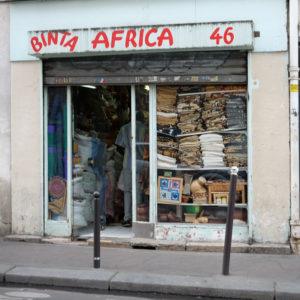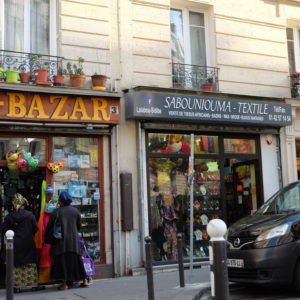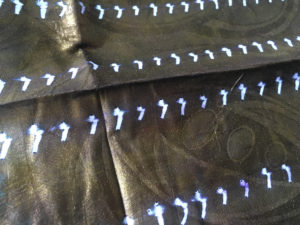My colleague Brittany Sheldon and I organized a panel for the 7th ECAS meeting in Basel, Switzerland, whose overall theme was encounters of urban and rural Africa. For our part, we were interested in the ways artists experience networks and travel. We noted that through their practice or through trade, many African art forms simultaneously cross (spatially) and maintain (conceptually) the boundaries between urban and rural. As artists, collectors, and objects travel, and as images, songs and videos fly from phone to phone, rural and urban zones become less differentiated while the mythologizing of the rural and its residents as a repository of traditional cultures seems to intensify.


Malian shops in the Chateau Rouge district of Paris
In my own time doing fieldwork, I heard many times that “in the village they know” or “in the village they still do that” (dye with natural indigo, for example).

Konyofini (wedding cloth) with hand-stitched resist pattern, dyed with synthetic indigo “palman” on bazin. Dyed in Mali, probably Bamako, purchased in Dakar.
My paper discussed the ways that Mande language speakers living in urban settings and overseas use personal and commercial networks to maintain access to certain important items, ‘traditional’ cloths or articles that are not economically or practically viable to produce in their home area, but may still be made in “the village” or hinterlands of Mali, Guinea, or Senegal. (But in some cases this “village” is a factory-like setting in Bamako!) Consumers depend on friends and family, or failing that, on merchants, to bring these important items to their new home.
These networks are inscribed on the bodies of fashionable West Africans when they dress for special occasions: access to cosmopolitan world fashion and connectedness to their home society and its traditions are equally interwoven with personal style and aesthetic acumen. The styles West Africans wear, particularly at key moments that reinforce relationships like weddings and naming parties, perform this connectivity.
The paper also pointed toward a question I will explore at length in the dissertation: what kinds of things are “traditional,” obligatory or “primordiale” in one consultant’s word–i.e., what are the qualities that one must go to “the village” to get, and why–and what kinds of things are open to changes, substitutions, transformations?
I loved visiting Basel, a charming medieval city. We swam in the Rhine!
Other conference highlights for me were the exhibition Making Douala, which explored the conditions of art in the Cameroonian city; a screening of the recent documentary Guangzhou Dream Factory; and several fine conference papers.